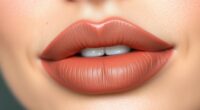To use essential oils safely, choose pure, high-quality products and check for certifications. Always dilute oils with carrier oils before topical use and follow proper application techniques. Use diffusers carefully, monitor any skin or breathing reactions, and avoid oils around pets and children. Store oils in dark bottles in a cool, dry place and be aware of shelf life. Continue exploring these practices to guarantee you harness aromatherapy’s benefits responsibly.
Key Takeaways
- Choose pure, certified essential oils from reputable sources to ensure safety and quality.
- Properly dilute oils with carrier agents before topical application to prevent skin irritation.
- Use diffusers and inhalation methods carefully, maintaining equipment cleanliness to avoid contamination.
- Follow safety guidelines, monitor for adverse reactions, and avoid oils around pets or sensitive individuals.
- Store oils in dark bottles in a cool, dry place, and be aware of their shelf lives to maintain potency.
Understanding Essential Oils and Their Benefits
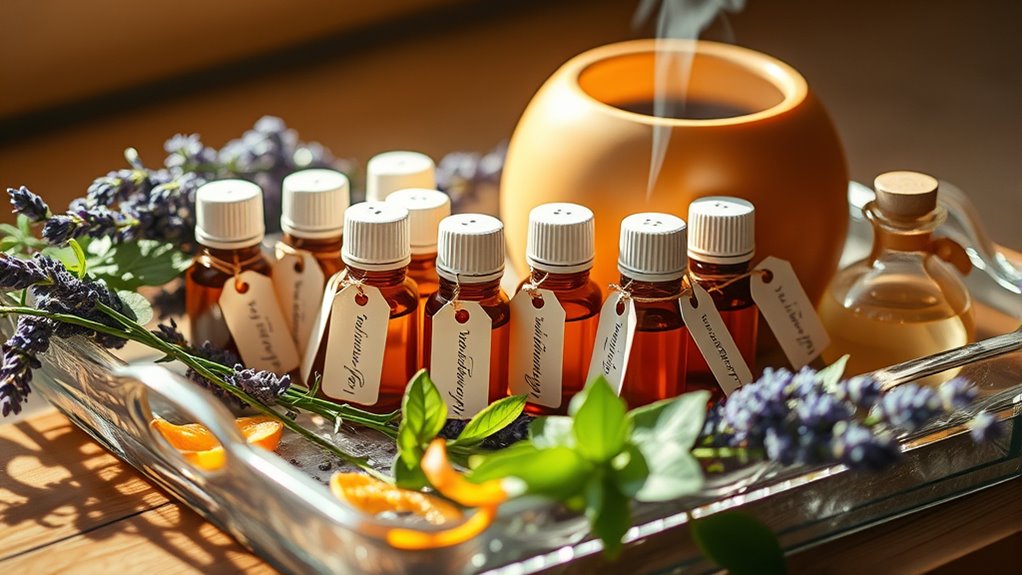
Have you ever wondered how essential oils can impact your well-being? Throughout history, essential oils have been valued for their healing and spiritual properties, from ancient Egypt to traditional Chinese medicine. These oils were used in rituals, medicines, and beauty treatments, showcasing their long-standing significance. Understanding the different types of essential oils and their specific benefits can further enhance your knowledge and safe practices. Additionally, awareness of cultural acceptance of these oils can inform responsible and ethical use of these oils in various contexts. Today, aromatherapy training helps you understand how to harness these natural extracts safely and effectively. Recognizing traditional applications and how they align with modern practices can help you appreciate their benefits and guides you in using them responsibly in your own wellness routine. Familiarity with appropriate dilutions is also essential to prevent adverse reactions and ensure safe usage.
Selecting High-Quality Essential Oils
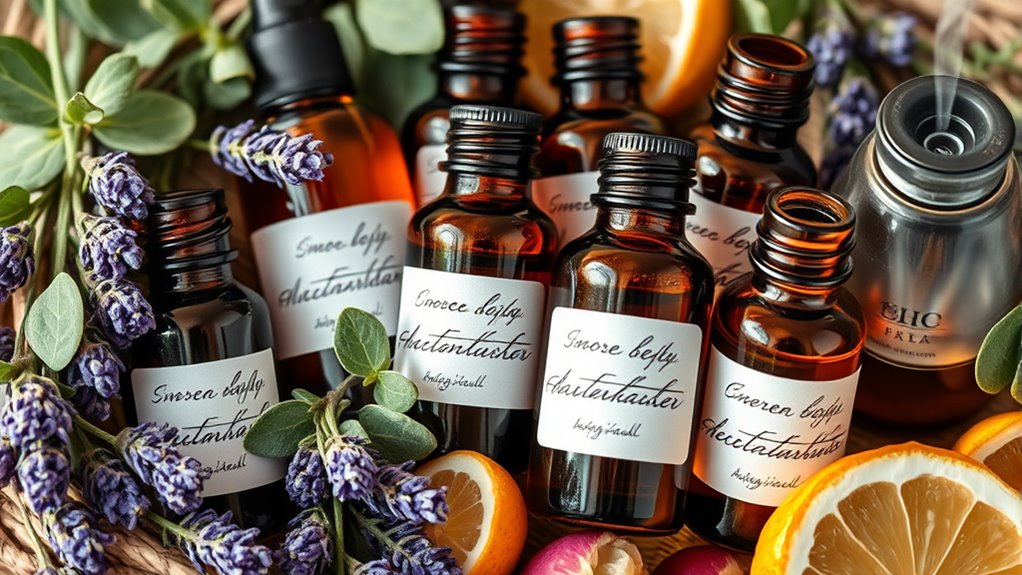
When choosing essential oils, you want to prioritize purity and authenticity to guarantee you’re getting a genuine product.
Look for oils that have undergone certification and testing to verify their quality and safety.
These steps help you select high-quality oils that deliver the best aromatherapy benefits.
Purity and Authenticity
How can you guarantee you’re getting the best quality essential oils? First, avoid oils labeled with synthetic fragrances, which are often misleading and lack therapeutic benefits. Authentic oils should be pure, derived directly from plants, without additives or synthetic scents. To further ensure quality, consider the transparency about sourcing and testing provided by reputable brands, which often include information about their practical support practices. Genuine essential oils will have a rich aroma, clear color, and remain stable over time. Additionally, aromatic cleaning properties can be an indicator of true purity, as authentic oils retain their natural scent and effectiveness. Incorporating mindfulness techniques during your selection process can help you better connect with the qualities of the oils and make informed choices. Understanding the local origins of the oils can provide insight into their purity and quality. Moreover, staying informed about the latest industry standards can help you identify high-quality sources. Remember, authentic oils are an investment in your health and well-being, so choose wisely to ensure you’re getting true purity and authenticity.
Certification and Testing
To guarantee you’re getting the highest quality essential oils, verifying certification and testing is vital. These certifications ensure the oils are pure, potent, and free from contaminants. To further ensure safety, look for oils that have undergone ethical testing procedures, which help verify that the products meet industry standards for safety and authenticity. When evaluating oils, consider:
- Certification labels from recognized organizations like USDA Organic or ISO standards
- Transparent lab testing results showing purity, safety, and chemical composition
- Documentation of testing standards used to verify quality and authenticity
Additionally, research indicates that validity and reliability of testing methods are crucial for ensuring product consistency and safety.
Methods of Application and Usage Techniques
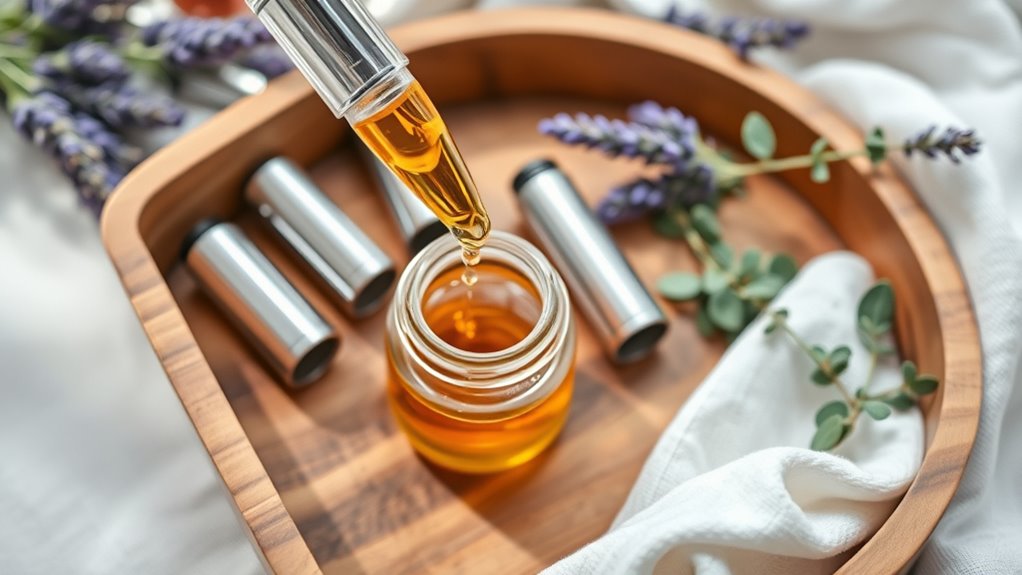
You can enjoy aromatherapy through diffusion and inhalation, which quickly deliver scents into your sense of smell for immediate relaxation or alertness. Using high-quality essential oils and proper equipment enhances safety and effectiveness during inhalation. Proper air quality can also influence the overall benefits of aromatherapy, making the environment more receptive to the essential oils’ effects. Additionally, ensuring that your diffusion devices are clean and well-maintained helps prevent the buildup of bacteria or mold that could compromise your safety. Regular cleaning of diffusers maintains optimal performance and prevents contamination, ensuring a safer experience. Topical application methods involve applying essential oils directly to your skin, but it’s important to dilute them properly to avoid irritation. Ensuring proper dilution practices minimizes the risk of adverse reactions and helps you experience the full benefits safely. When blending oils for topical use, consider harmonious combinations to enhance their therapeutic effects and avoid skin reactions. Understanding these techniques helps you choose the best way to experience the benefits of your essential oils safely. Being aware of safety precautions and proper dilution practices ensures a positive and risk-free aromatherapy experience.
Diffusion and Inhalation
Diffusion and inhalation are popular methods for experiencing the therapeutic benefits of essential oils. When you use a diffuser, you can create a calming or invigorating environment by dispersing aromatic molecules into the air. This method aligns with aromatherapy protocols, allowing you to customize sessions with DIY diffuser blends tailored to your needs.
Inhalation provides quick relief for congestion or stress, simply by breathing in the scent directly from a bottle or inhaler. To enhance your experience, consider these options:
- Using ultrasonic diffusers for continuous, safe aromatic dispersion
- Creating personalized blends with essential oils suited for inhalation
- Incorporating inhalation into your daily routines for mood support or relaxation
Additionally, understanding the proper essential oil dilution techniques ensures safe use during diffusion and inhalation. Diffusion and inhalation are simple, effective ways to enjoy essential oils safely and effectively, supporting your overall well-being.
Topical Application Methods
Applying essential oils directly to the skin offers a convenient and effective way to experience their benefits. To do this safely, always dilute the essential oil with a carrier oil, like coconut or jojoba, to improve skin absorption and reduce irritation. Using proper dilution techniques ensures safe and effective topical application, maximizing the benefits while minimizing potential risks. Proper dilution also helps maintain the integrity of the essential oils, preventing degradation and contamination. Additionally, applying essential oils to specific targeted areas can enhance their effectiveness and help address particular concerns. Proper dilution also aligns with recommended safety guidelines for essential oil use. Monitoring skin reactions during application can help prevent adverse effects and ensure safe use. Consistent, proper application enhances absorption and ensures you get the maximum benefits from each session.
Dilution and Safe Topical Use
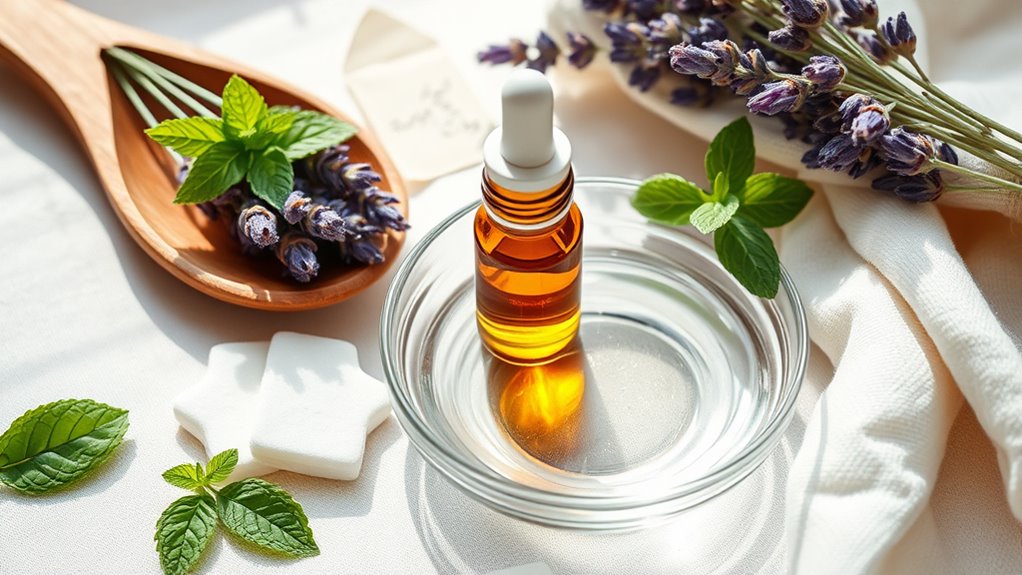
Since essential oils are highly concentrated, proper dilution is crucial to guarantee safe topical use. Using carrier oils helps reduce the risk of irritation and ensures safe application. Follow recommended dilution ratios to avoid adverse reactions, especially for sensitive skin. Additionally, proper installation and venting can help maintain the integrity of the oils and prevent safety hazards. For example, a typical dilution for adults is 2-3%, which means adding a few drops of essential oil to a teaspoon of carrier oil. Visualize applying a gentle massage oil or a soothing body blend. Keep in mind that using too much essential oil can cause skin irritation or sensitization. Always perform a patch test before extensive use.
Inhalation and Diffusion Practices
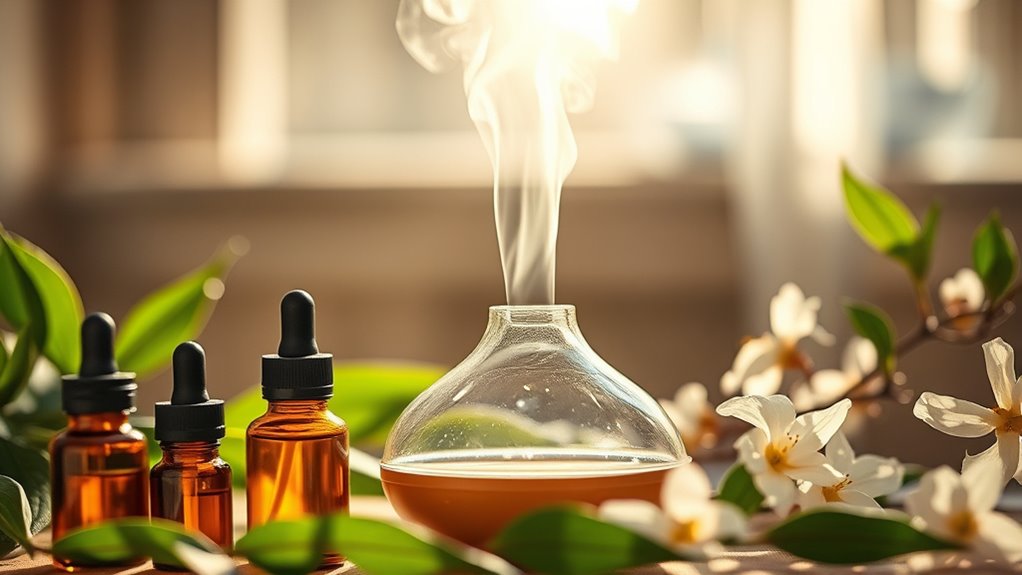
Inhalation and diffusion are popular methods for experiencing the therapeutic benefits of essential oils. They allow you to enjoy aromatherapy without direct skin contact. To guarantee safety and effectiveness, understand common aromatherapy myths, such as the idea that diffusion eliminates all risks. Proper diffuser maintenance is essential to prevent mold and buildup, which can reduce scent quality and pose health risks. Use the table below to help you choose the right diffuser and maintain it properly:
| Diffuser Type | Benefits | Maintenance Tips |
|---|---|---|
| Ultrasonic | Quiet, disperses fine mist | Clean weekly with alcohol |
| Nebulizing | Pure, concentrated scent | Regularly check for clogs |
| Heat-Based | Simple, affordable | Avoid overheating; clean regularly |
Recognizing and Avoiding Allergic Reactions
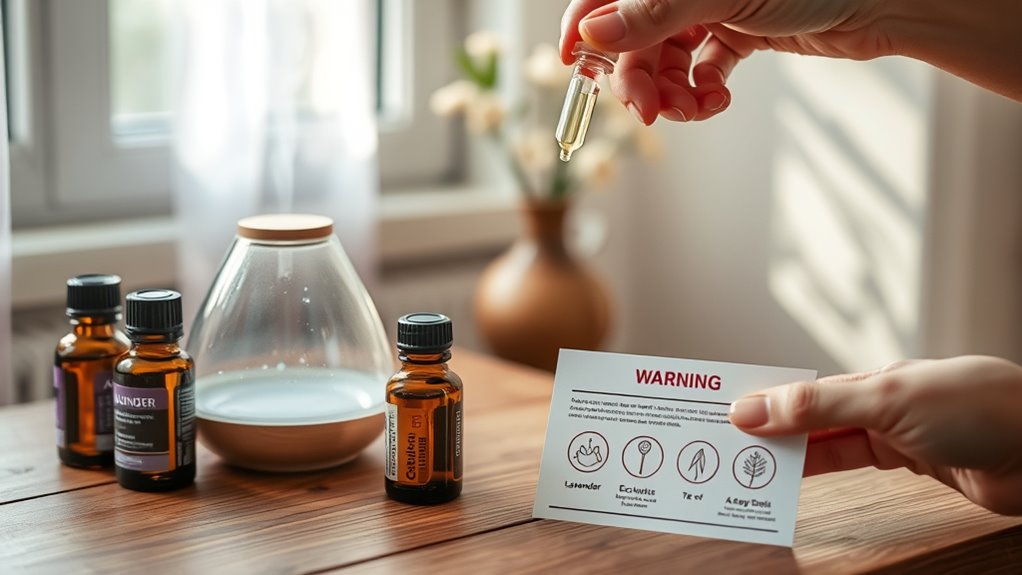
While diffusion methods help you enjoy the benefits of essential oils safely, it’s important to recognize that some people may experience allergic reactions. Pay attention to allergic reaction symptoms such as sneezing, skin irritation, or breathing difficulties.
Be aware that some individuals may develop allergic reactions like sneezing, skin irritation, or breathing issues.
To prevent issues, start with small amounts and monitor your body’s response. Be mindful of pet allergy prevention, as animals can also react strongly to certain oils, leading to symptoms like watery eyes or coughing.
Always test a small patch of skin before extensive use, and avoid diffusing oils if you notice any adverse reactions. If you experience symptoms, discontinue use immediately and consult a healthcare professional.
Recognizing early signs helps prevent more serious reactions and keeps your aromatherapy experience safe.
Special Precautions for Sensitive Groups
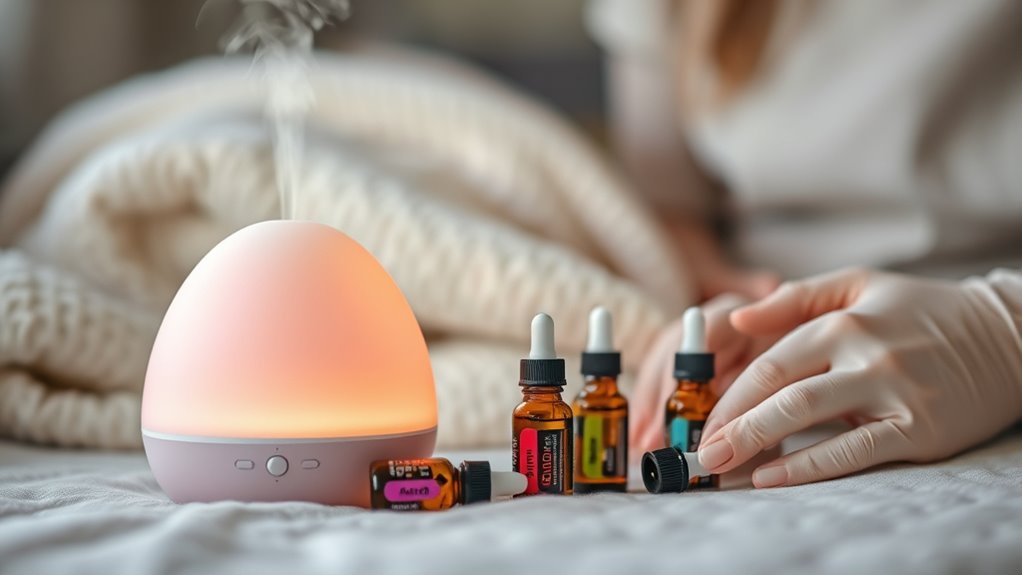
People with sensitive skin, children, pregnant women, and the elderly should take extra precautions when using essential oils.
For pediatric precautions, always dilute oils appropriately and consult a healthcare professional before use. Children’s skin is more sensitive, so use lower concentrations and avoid certain oils altogether.
Pregnancy considerations are also vital; some essential oils can trigger contractions or harm fetal development. Pregnant women should avoid oils like clary sage or cinnamon and seek guidance from a qualified aromatherapist.
The elderly may have thinner, more fragile skin and underlying health conditions, increasing their risk of adverse reactions. Always perform a patch test and start with small amounts.
When in doubt, consult a healthcare provider to guarantee safe and effective use of essential oils for these sensitive groups.
Storage and Shelf Life of Essential Oils
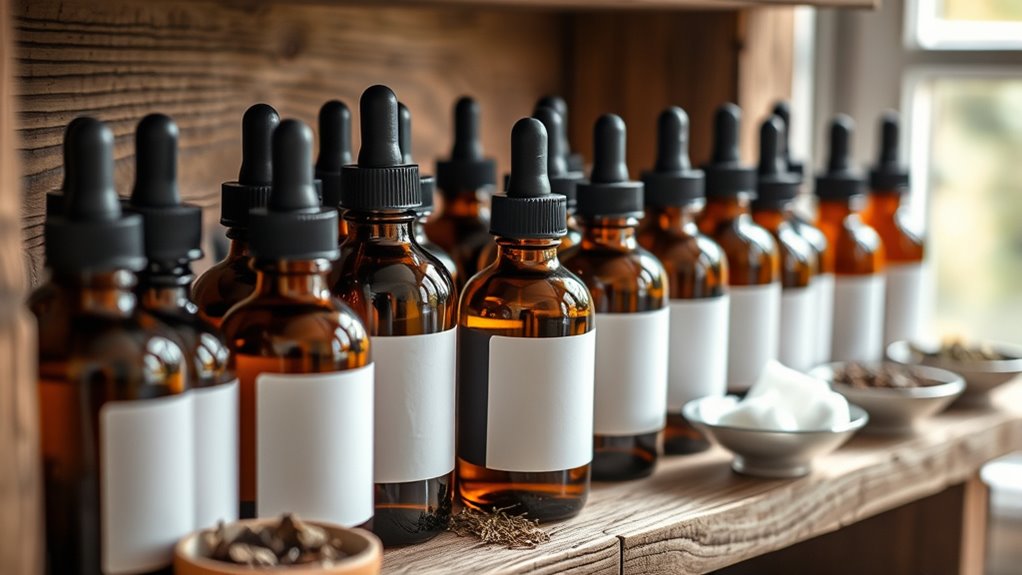
Proper storage is key to maintaining the potency and safety of your essential oils. When stored correctly, they last longer and retain their therapeutic properties.
Keep essential oils in dark glass bottles to protect against light degradation, which can reduce their effectiveness. Store them in a cool, dry place away from heat sources and direct sunlight to prevent oxidation.
Store essential oils in dark bottles in a cool, dry, and sunlight-free place to preserve their potency and safety.
For ideal essential oil blending, use containers made specifically for essential oils, avoiding plastic that can absorb scents or degrade. Label each bottle clearly with the oil type and purchase date to monitor shelf life.
Typically, citrus oils last 6-12 months, while woody and resinous oils can last several years. Proper storage choices ensure your oils stay fresh, potent, and safe to use over time.
Frequently Asked Questions
Can Essential Oils Be Ingested Safely?
You should never ingest essential oils unless guided by a qualified professional. Internal application can be risky, and some oils are toxic if swallowed.
While aromatherapy diffusers safely disperse essential oils into the air for inhalation, ingesting them can cause serious health issues.
Always follow safety guidelines and consult an expert before considering internal use, as improper ingestion can be dangerous and lead to adverse reactions.
How Do I Identify Authentic Versus Adulterated Oils?
To identify authentic essential oils, focus on oil sourcing and purity verification. Authentic oils come from reputable suppliers who provide transparent information about their sourcing practices.
Look for oils that are labeled pure, with no synthetic additives or fillers. Check for clear, natural scents without chemical odors.
You can also request third-party testing results to confirm purity. Trust your senses and choose brands committed to high-quality, authentic essential oils.
Are There Essential Oils Suitable for Children?
Yes, there are child-safe oils suitable for pediatric aromatherapy. You should choose gentle, diluted essential oils like lavender, chamomile, and mandarin.
Always use these oils in very low concentrations and avoid certain strong oils such as peppermint or eucalyptus, which can be too harsh for children.
Before using any essential oil on or around children, consult a healthcare professional to guarantee safe application and proper dilution.
What Are the Signs of Essential Oil Toxicity?
Imagine a child rubbing their eyes after inhaling too many essential oils. Signs of toxicity include skin irritation, breathing difficulties, or dizziness.
Overuse symptoms often involve headaches, nausea, or fatigue. If you notice these, stop use immediately and seek medical advice.
Keep essential oils out of reach, dilute properly, and monitor reactions carefully to prevent adverse effects and guarantee safe use for everyone.
How Often Should I Use Essential Oils for Best Results?
For the best results, you should use essential oils with careful attention to application frequency and ideal usage. Typically, applying 1-2 times daily is effective, but avoid overuse to prevent irritation or sensitization.
Pay close attention to your body’s responses, and adjust the frequency accordingly. Always dilute essential oils properly and follow recommended guidelines to guarantee safe, beneficial use while enjoying their therapeutic benefits.
Conclusion
Now that you know the basics of using essential oils safely, you can enjoy their benefits with confidence. Did you know that the global aromatherapy market is expected to reach $2.4 billion by 2025? By choosing high-quality oils, practicing proper application, and respecting safety guidelines, you’ll maximize their positive effects while minimizing risks. Remember, safety first—your well-being is worth it!

